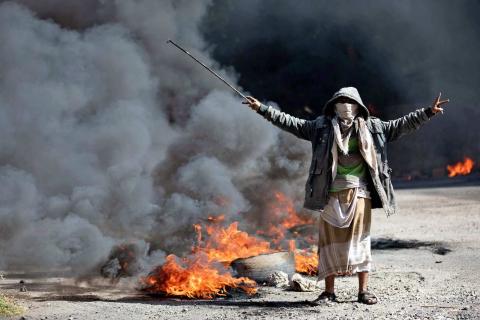South Asia is integral to China’s Belt and Road vision. As an intersection point between the proposed “Silk Road Economic Belt” and the “21st Century Maritime Silk Road”, China sees South Asia as a “priority zone” for promoting its Belt and Road Initiative. It also helps that South Asia is an area where the prospect of early harvests is among the highest.
China’s South Asia policy has long been centred on maintaining a strategic balance in the region, often pitching nuclear Pakistan against nuclear India.
Yet the opportunities are not without challenges. Research reports and academic papers released by Chinese think tanks in recent months are particularly illuminating in this respect, as opposed to the opaque nature of China’s official discourse on the BRI. Chinese strategists see three evolving trends in South Asia that they argue pose severe challenges to the promotion of the BRI in the region. The hope in charting these problems seems to be to encourage timely intervention by Chinese policymakers.
“Intensifying strategic imbalance”
China’s South Asia policy has long been centred on maintaining a strategic balance in the region, often pitching nuclear Pakistan against nuclear India. However, of late, particularly after the inception of the US’s new Free and Open Indo-Pacific strategy, there is a growing consensus within the Chinese strategic circles that the tried and tested policy of balancing India with Pakistan might not be a sustainable one.
The argument among Chinese scholars goes that a politically stable, economically buoyant India has more room to manoeuvre in the field of diplomacy. Scholars have expressed astonishment that India has not only intensified its ties with the US and Japan, who in turn are supporting a bigger role for India in South Asia, but has also maintained close relations with its traditional friend Russia, which wholeheartedly supported India’s entry into the Shanghai Cooperation Organisation (SCO).
Conversely, Chinese strategists term the environment inside and outside Pakistan as “worrying”. As one academic paper released by an authoritative Chinese think tank, China Institute of International Studies (CIIS), put it:
The political situation is turbulent, the economic development is encountering bottlenecks, the society is plagued with grave security lapses and its strategic scape is increasingly being curtailed by the US and India, who want to label it as a failed nation or a terrorist nation.
It is easy to imagine the recent tension over Kashmir has only intensified this concern.
China is even more disappointed with Pakistan’s internal political bickering having a negative impact on the construction of the China-Pakistan Economic Corridor, China’s flagship project under the BRI in South Asia.
Interestingly, the CIIS paper highlighted the need to urge the Pakistani side not to burden the China-Pakistan friendship with undue expectations. Its message to Pakistan is two-fold: that Pakistan’s internal problems such as unbalanced development must be resolved by the Pakistani leadership, and not by China through the CPEC; and that CPEC has a business operation model and is not a welfare project.
The challenge of debt
The rising debt level of South Asian nations is another major challenge.
China’s role in causing unsustainable debt burden on Belt and Road countries attracted global attention for the first time in 2017 when a cash-strapped Sri Lanka handed over the China-financed Hambantota Port to a Chinese state-run company on a 99-year lease. This gave rise to the popular narratives of “China’s debt trap diplomacy” and “predatory economics”, which eventually led to the review of several Chinese projects in different South Asian nations over “debt anxiety” around Chinese investments.
Another publication mentioned that this episode not only brought major economic losses to Chinese investors but also jeopardised the international reputation of the Belt and Road Initiative.
Beijing, in its defence, argued the debt problem in South Asian countries has historical origins, mainly caused by their own economic structural defects and unique national conditions. It also claimed that Chinese investment in South Asia has only increased in recent years while Western nations and multilateral organisations have been the major creditors in the past, so must take some responsibility for causing the debt crisis.
Yet some sections in Chinese strategic community acknowledge the rising dissatisfaction about Chinese projects in South Asia, attributing it to the glaring imbalance that exists in China’s economic relations with these nations and China’s failure to boost local employment and improve local people’s livelihood through its projects.
The narrative in South Asia about the BRI, according to a CIIS report, oscillates between two contradictory standpoints – where it is bluntly denounced for being a strategic project delivering unilateral gains to China, versus a view where the large-scale Chinese investments are regarded as expensive freebies with everyone vying to get a piece.
Rising security threats
China’s third concern is about the tense security situation in the Afghanistan-Pakistan region, which has a spillover effect for the entire of South Asia. The situation in Afghanistan, Chinese specialists note, has deteriorated further with the NATO coalition forces headed by the US military withdrawing sharply and the prospect of the Taliban returning to political power once again.
China is also not very hopeful of the Afghan peace process making a major breakthrough in the short term. Meanwhile in Pakistan, Chinese experts see four extremist forces who pose the biggest threat to the proposed CPEC, which include: the Provincially Administered Tribal Area (PATA) based terrorist organisations that oppose the Pakistani military and political system; agents of East Turkestan Movement; separatist forces in Baluchistan province; and extremists in Sindh.
Calling it a “complex situation testing Chinese wisdom”, the Chinese strategic community seems keen to relook at the country’s BRI strategy in South Asia, with greater focus on solving the cooperation dilemma with India and properly managing the relationship with small and medium-sized countries. In their view, it also requires intensifying economic as well as security cooperation with Pakistan, Afghanistan, and the adjoining region under the banner of CPEC.

